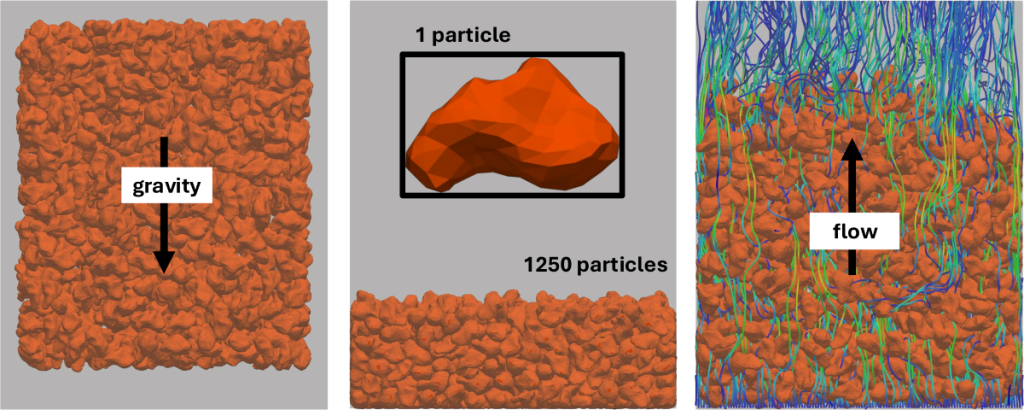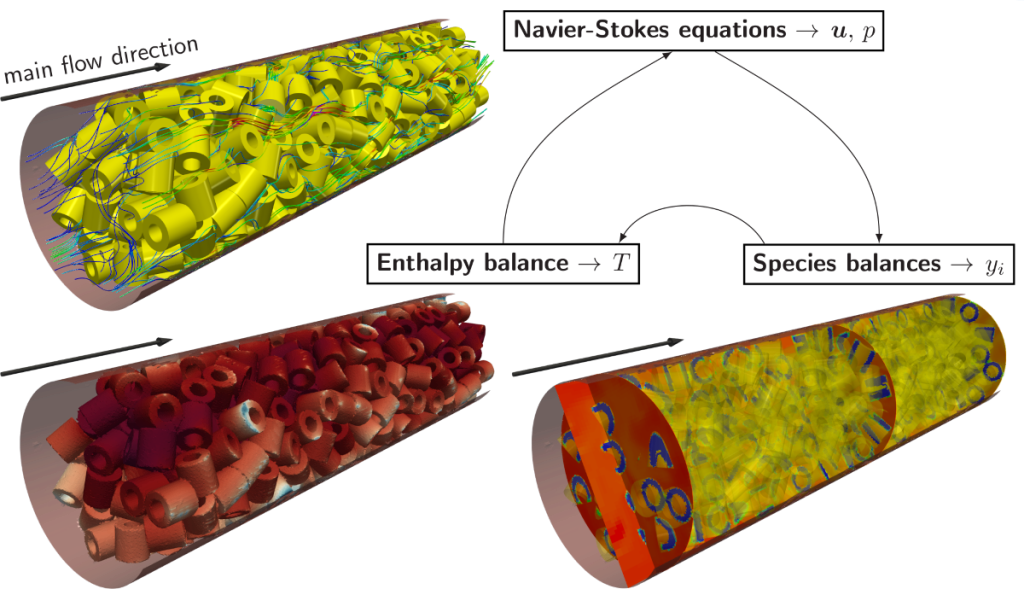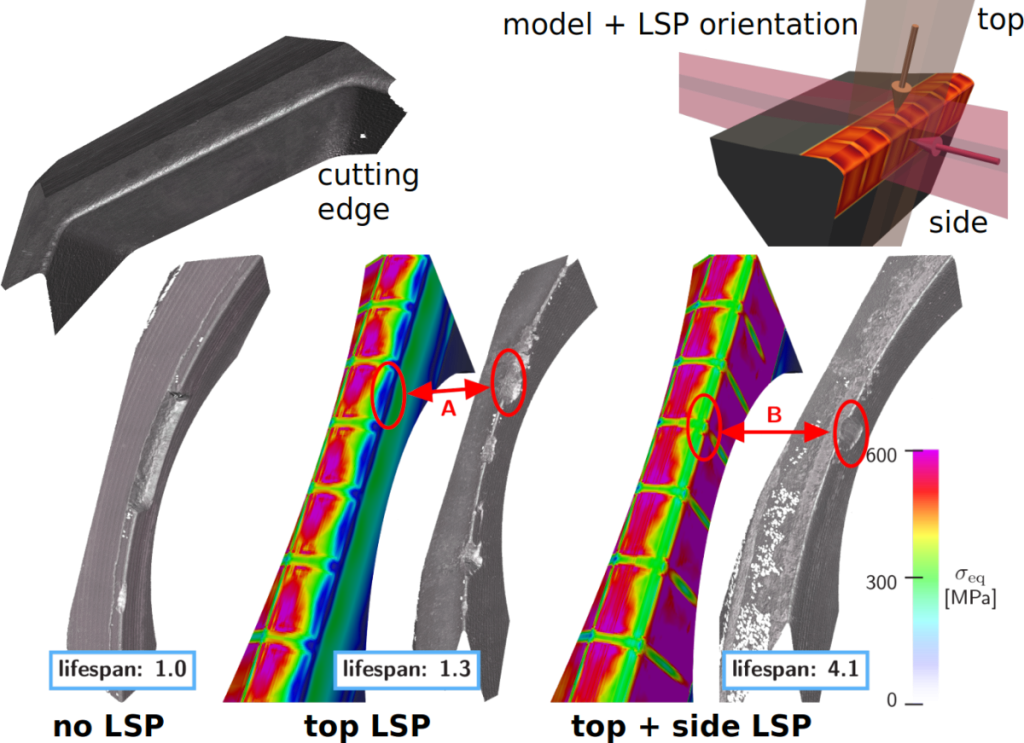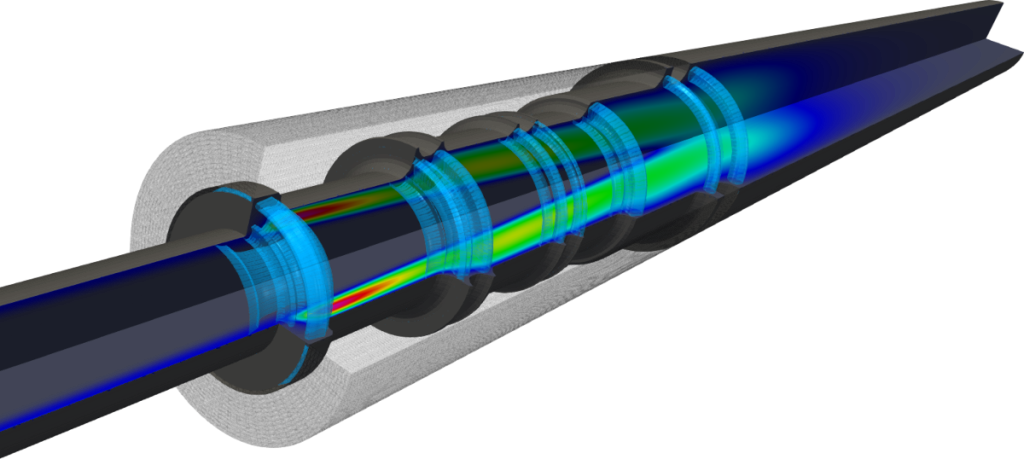Laboratory of Technical Mathematics
|
Department: Department of Impact and Waves in Solids Head: Ing. Martin Isoz, Ph.D. |
|
The Laboratory of Technical Mathematics (techMathGroup) is engaged in developments of numerical methods and computing algorithms for nonlinear static and dynamic problems in different fields of computational continuum mechanics. We are interested in fluid-particles systems with the emphasis being made on irregular particles and contact treatment in such systems. Additionally, a considerable attention is being given to development of numerical tools for simulation of reactive heterogeneously catalyzed incompressible and non-isothermal flow, and for industrially applicable simulations of the laser shock peening. At last but not at least, we are working in the fields of model order reduction, topology optimization, and flow analysis. |
Ing. Pavel Gruber, Ph.D.
Ing. Martin Isoz, Ph.D.
Ing. Ján Kopačka, Ph.D.
RNDr. Pavel Kotalík, Ph.D.
PhD students:
Ing. Marek Belda
Ing. Tomáš Hlavatý
Ing. Ondřej Ježek
Ing. Anna Kovárnová
Ing. Lucie Kubíčková
Ing. Ondřej Studeník
MSc students:
Bc. Matyáš Khýr
Bc. David Voborský
Bc. Martin Lédl
BSc students:
Milana Dejaková
Ivana Havlenová
Jakub Rýc
Jarmila Terpáková
Vít Večerník
Developing of CFD-DEM solver and simulating turbulence with immersed boundary method
OpenHFDIB-DEM is an extension to the OpenFOAM library allowing for particle-resolved simulations of flow laden with arbitrarily-shaped particles. The inclusion of solid phase into the CFD mesh is based on the immersed boundary method and implemented using the OpenFOAM toolbox. The DEM part of the code is completely in-house developed; yet, it is compatible with OpenFOAM and the complete software solution is monolithic - CFD has a full access to all the DEM variables and vice versa. The code is open-source and publicly available on github.

Github repository: techMathGroup/openHFDIB-DEM
Related to the CFD-DEM research is the investigation of the possibilities of coupling Reynolds-averaged simulations of turbulent flow with the immersed boundary method. Here, the aim is at least qualitatively correct simulation of turbulence close to the unresolved immersed fluid-solid interface. In other words, we are working on coupling the immersed boundary method and wall functions. Once more, the code is open-source and publicly available.
Github repository: techMathGroup/openHFDIBRANS
Researchers: M. Isoz, O. Studeník, L. Kubíčková, M. Dejaková, J. Terpáková
Collaboration: Monolith Research Group, University of Chemistry and Technology, Czechia; School of Hydro Science & Engineering, Taiyuan University of Technology, China; Faculty of Natural Sciences, University Ústí nad Labem, Czechia; RED CFD Ltd., Italy; Exeter Small-Scale Robotics Laboratory, University of Exeter, United Kingdom
Related papers:
[2] Kotouč Šourek, M.; Studeník, O.; Isoz, M.; Kočí, P.; York, A.P.E.: Viscosity prediction for dense suspensions of non-spherical particles based on CFD-DEM simulations. Powder Technology, 444 (2024) 120067, DOI: 10.1016/j.powtec.2024.120067
[3] Studeník, O.; Isoz, M.; Kotouč Šourek, M.; Kočí, P.: OpenHFDIB-DEM: An extension to OpenFOAM for CFD-DEM simulations with arbitrary particle shapes. SoftwareX 27 (2024) 101871, DOI: 10.1016/j.softx.2024.101871
Simulations of heterogeneously-catalyzed reactive flow
A significant portion of our research is oriented towards development of CFD solvers for heterogeneously-catalyzed reactive flow. The solvers allow for non-isothermal simulations with high concentrations of reactive species (mass-based transport formulation with Stefan-Maxwell diffusion taken into account). All the CFD codes are implemented in the OpenFOAM library. For practical applications of our research, we collaborate with several national and international laboratories.

Researchers: T. Hlavatý, M. Isoz, M. Khýr, J. Rýc
Collaboration: Monolith Research Group, University of Chemistry and Technology, Czechia; Department of Carbohydrates and Cereals, University of Chemistry and Technology, Czechia; Oak Ridge National Laboratory, United States of America; Faculty of Natural Sciences, University Ústí nad Labem, Czechia; BEAS, a.s., Czechia
Related papers:
[2] Kočí, P.; Isoz, M.; Plachá, M.; Arvajová, A.; Václavík, M.; Svoboda, M.; Price, E.; Novák, V.; Thompsett, D;: 3D reconstruction and pore-scale modeling of coated catalytic filters for automotive exhaust gas aftertreatment. Catalysis Today, 320 (2019), 165-174, DOI: 10.1016/j.cattod.2017.12.025
[3] Wehinger, G.D.; Ambrosetti, M.; Cheula, R.; Ding, Z.-B.; Isoz, M.; Kreitz, B.; Kuhlmann, K.; Kutscherauer, M.; Niyogi, K.; Poissonnier, J.; Réocreux, R.; Rudolf, D.; Wagner, J.; Zimmermann, R.; Bracconi, M.; Freund, H.; Krewer, U.; Maestri, M.: Quo vadis multiscale modeling in reaction engineering? - A perspective. Chemical Engineering Research And Design, 184 (2022), 39-58, DOI: 10.1016/j.cherd.2022.05.030
[4] Hlavatý, T.; Kočí, P.; Isoz, M.; Deka, D.; Partridge, W.: Balanced Fast-SpaciMS capillary configurations provide practically noninvasive channel-average measurements in catalytic monoliths. Chemical Engineering Science, 282 (2023), 119272, DOI: 10.1016/j.ces.2023.119272
Finite-volume-based simulations of laser shock peening
The most applied problem solved in the Laboratory of Technical Mathematics comprises developments of methods for industrial simulations of laser shock peening (LSP). The complete framework is implemented using the OpenFOAM library, which is based on the finite volume method. Consequently, LSP, which comprises propagation of an elastoplastic shockwave with time-scales in nanoseconds and magnitude in GPa, can be simulated even on imperfect meshes.

Researchers: M. Isoz, P. Gruber, D. Voborský
Collaboration: HiLASE Centre, Institute of Physics of the Czech Academy of Sciences, Czechia; SHM, s.r.o., Czechia; Centrum Výzkumu Řež s.r.o., Czechia; COMTES, FHT a.s.; Embraer, Brazil; Welle Laser Technology, Brazil; EMBRAPII Unit Laser Technologies, Brazil
Optimization and model order reduction
In order to be able to use complex models developed within other research directions honed in the laboratory in industry-relevant optimizations, we are active in two intertwined directions: (i) development of methods for multiobjective optimization in general and shape and topology optimization in particular, and (ii) development of methods for a-posteriori model order reduction, including both projection-based and AI-based approaches.
A notable result is development of an algorithm for CFD-based shape optimization. The algorithm is based on evolutionary algorithms (NSGA-II), but it is enriched by adaptive sample selection and training of an AI-based surrogate model. Altogether, the approach can significantly speed-up the later stages of optimization and can enrich the found set of pareto-optimal solutions compared to a purely-based optimization. The algorithm is open-source and publicly available.

Github repository: techMathGroup/CFDNNetAdapt
Furthermore, we are developing methods for model order reduction of transport-dominated systems. The method is called "shifted proper orthogonal decomposition with interpolation via ANNs (sPODIANN)" and is based on combining transport reversal approaches to achieve low rank data approximation with artificial neural networks that provide the sought low-rank surrogate. The sPODIANN developments are motivated mostly by efforts to achieve computationally feasible parametric studies based on CFD-DEM simulations.
Finally, we are using proper orthogonal decomposition, dynamic mode decomposition, and methods based on image analysis to analyze dynamic turbulent flow and to validate its simulation.
Researchers: L. Kubíčková, A. Kovárnová, M. Isoz, M. Belda, T. Hlavatý, I. Havlenová
Collaboration: I2M, Aix-Marseille Université, France; Institute for Hydrodynamics, Czech Academy of Sciences, Czechia
Related papers:
FEM software PMD (Package for Machine Design)
PMD is a modern, platform-independent package of computer programs based on the Finite Element Method (FEM). The package is designed for general engineering problems in the continuum mechanics of solids. It is a proprietary code with a long, 35-year tradition, and is currently maintained by the staff of the Laboratory of Computational Solid Mechanics. The package also features its own GUI pre- and post-processor. More information about PMD can be found here.
Researchers: J. Dobiáš, D. Gabriel, J. Kopačka, R. Marek, J. Masák, J. Novotný, P. Pařík, J. Plešek, S. Pták
Collaboration: VAMET Ltd.
The computational research of techMathGroup is powered by a local HPC cluster at the Institute of Thermomechanics of the CAS. As of 2024, the cluster comprises 656 cores organized in 15 nodes. Total available RAM is 4.160 TB. However, the cluster is regularly updated; thus, the here-provided information may be outdated.
The group has expertise using several packages and programming environments, all of them open-source. Our work is built primarily on the OpenFOAM C++ CFD library, which is based on the finite volume method. Furthermore, we are proficient in python and bash programming, and usage of Blender and Paraview, particularly for preparation of system geometries and case postprocessing. The AI-related research is performed using TensorFlow/Keras.
- Topic: Post-processing the results of the topology optimization with the level-set technique
- Supervisor: Ing. Dušan Gabriel, Ph.D.
- Consultant: Ing. Ján Kopačka, Ph.D.
- Start year: 2019
- Expected year of graduation: 2025
- Topic: Mathematical modeling and model order reduction for reactive flows
- Supervisor: prof. Jiří Furst, Ph.D.
- Consultant: Ing. Martin Isoz, Ph.D.
- Start year: 2022
- Expected year of graduation: 2026
- Topic: Development of CFD-DEM methods for simulated movement and interactions of solid particles in heterogeneous reactors
- Supervisor: prof. Petr Kočí, Ph.D.
- Consultant: Ing. Martin Isoz, Ph.D.
- Start year: 2022
- Expected year of graduation: 2026
- Topic: Topology optimization for chemical engineering applications
- Supervisor: Ing. Martin Isoz, Ph.D.
- Consultant: Ing. Jan Haidl, Ph.D.; prof. Ing. Miroslav Šóoš, Ph.D.
- Start year: 2023
- Expected year of graduation: 2027
- Topic: Developing novel techniques for validating numerical models of flow dynamics
- Supervisor: doc. Ing. Tomáš Hyhlík, Ph.D.
- Consultant: Ing. Martin Isoz, Ph.D.
- Start year: 2023
- Expected year of graduation: 2027
- Topic: Model order reduction and optimization in engineering applications
- Supervisor: Ing. Martin Isoz, Ph.D.
- Consultant: doc. Ing. Jan Švihlík, Ph.D.
- Start year: 2024
- Expected year of graduation: 2028

